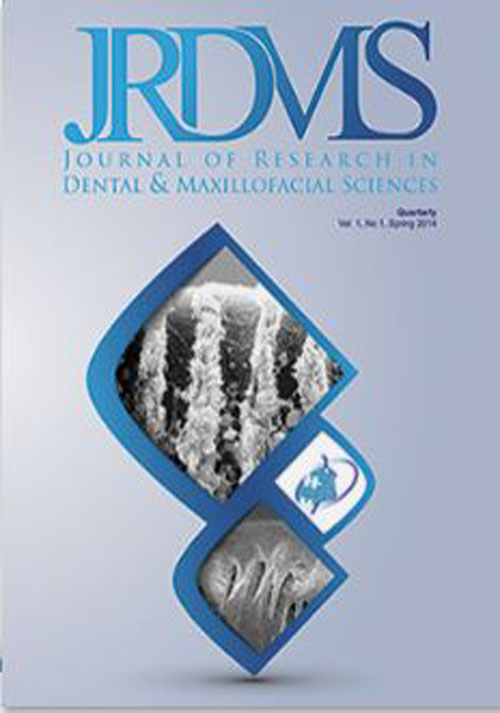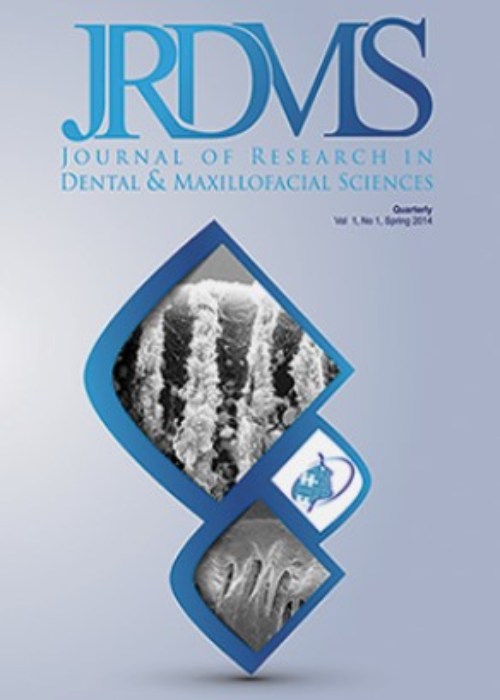فهرست مطالب

Journal of Research in Dental and Maxillofacial Sciences
Volume:7 Issue: 2, Spring 2022
- تاریخ انتشار: 1401/01/22
- تعداد عناوین: 8
-
-
Pages 55-61Background and Aim
This study aimed to assess the bone
thickness at the interradicular spaces in the anterior mandible on cone-beam computed tomography (CBCT) scans of patients to find appropriate sites for mini-implant and miniscrew placement.Materials and MethodsThis analytical cross-sectional study was conducted on 161 CBCT scans of patients (98 females and 63 males) between 18 to 50 years old presenting to the School of Dentistry ofIslamic Azad University in 2020. Cross-sectional images with 1 mm slice thickness were evaluated to measure the bone thickness at the interradicular areas at 3, 6, 9, 12, 15, and 18 mm distance from the mandibular alveolar crest. The measurements made from the distal surface of right canine to the distal surface of left canine teeth were recorded. The CBCT scans had been taken by Rotograph Evo 3D CBCT scanner, and were analyzed by OnDemand3D software. Data were statistically analyzed by t-test.
ResultsBone thickness at 11 sites in the anterior mandible was significantly higher in males (P<0.05). By an increase in depth in both males and females, the mean thickness of bone increased (P<0.05). The maximum mean bone thickness in males and females was at 18 mm depth between the central incisors.
ConclusionTo find a correct site for mini-implant and miniscrew placement, it should be noted that bone thickness would be greater at deeper areas, and by moving from the premolar site towards the incisors.
Keywords: Mandible, Bone Screws, Cone-Beam Computed Tomography -
Pages 62-70Background and Aim
This study evaluated the effect of pomegranate peel and green tea extracts on shear bond strength (SBS) of a microhybrid composite to bleached enamel.
Materials and MethodsIn this in vitro, experimental study, 44 maxillary premolars were divided into 4 groups of control A (composite cylinders bonded to teeth without bleaching), group B (composite bonding immediately after bleaching), group C (5 g of green tea extract was dissolved in 100 mL of distilled water, applied for 10 minutes, and rinsed for 30 seconds, followed by bleaching and composite bonding) and group D (5 g of pomegranate peel extract was dissolved in 100 mL of distilled water; the rest was similar to group C). In groups B, C and D, 35% hydrogen peroxide was applied on the teeth for 20 minutes and rinsed. This process was repeated two more times. The teeth were etched with 35% phosphoric acid for 15 seconds and rinsed for 15 seconds. A microhybrid composite was applied in Tygon tubes, bonded to the teeth with single Bond, and light-cured. Mode of failure was also determined. SBS was measured by a universal testing machine and data were analyzed by one-way ANOVA and Tukey’s test.
ResultsA statistically significant difference was found in the mean SBS of the groups (P<0.001). The mean SBS of group B (not treated with antioxidant after bleaching) was significantly lower than that in other groups (P<0.05).
ConclusionApplication of 5% pomegranate peel and green tea extracts increase the SBS of composite to bleached enamel.
Keywords: Shear strength, Antioxidants, Dental Enamel, Tooth bleaching -
Pages 71-77Background and Aim
Periodontal disease may cause adverse pregnancy outcomes such as low birth weight (LBW) or preterm birth (PTB). In the present study, mothers with one of these two delivery complications were analyzed regarding presence/absence of periodontal disease as a possible risk factor in comparison with related medical risk factors.
Materials and MethodsIn this cross-sectional study, the sample included 50 women admitted to Afzalipour Hospital in Kerman. All mothers had a history of PTB or LBW in their recent delivery. Medical risk factors including intra -uterine growth restriction (IUGR), premature rupture of the amniotic membrane (PROM) and vaginal bleeding in addition to periodontal parameters including bleeding on probing (BOP), plaque index (PI) and attachment loss were recorded. Descriptive indices, Spearman’s coefficient, logistic regression model, and receiver-operating characteristic (ROC) curve were used for data analysis.
ResultsAll patients had various forms of periodontal involvement; 86% had periodontitis. The frequency of periodontitis was significantly higher than medical risk factors (P=0.024). The area under the curve (AUC) demonstrated higher discriminating power for maternal periodontal parameters in comparison with medical risk factors.
ConclusionMaternal periodontal disease appears to be an independent risk factor for PTB and LBW.
Keywords: Infant, Low Birth Weight, Periodontal Diseases, Pregnancy, Premature Birth -
Pages 78-86Background and Aim
This study assessed the salivary calcium level, salivary flow rate, and dental problems of patients with Sjogren’s syndrome.
Materials and MethodsThis case-control study was conducted on 30 patients with Sjogren’s syndrome and 30 healthy controls. The salivary flow rate, salivary calcium level, and the decayed, missing, and filled surfaces (DMFS) index were recorded. The total salivary concentration of calcium was assessed by atomic absorption spectrometry using Arsenazo III calcium-sensitive dye. The Kolmogorov-Smirnov test, the parametric independent t-test, and the Mann Whitney U test were used to compare the variables between the two groups. The Pearson’s and the Spearman’s correlation coefficients were used to analyze the relationship between quantitative variables.
ResultsThe salivary calcium level was insignificantly higher in the case group (4.44±0.78 mg/dL versus 4.22±0.51 mg/dL, P=0.189, independent t-test). The salivary flow rate in patients with Sjogren’s syndrome was significantly lower than that in controls (0.12±0.07 mL/minute versus 0.4±0.14 mL/minute, P<0.0001, Mann Whitney U test). The cut-off point for discrimination of patients with Sjogren’s syndrome was 0.165 mL/minute with 96% sensitivity and 90% specificity. The DMFS score was higher in the case group (78.08 versus 38.35, P<0.0001 based on independent t-test). The salivary flow rate was responsible for 34% of the changes in DMFS score while the calcium level was responsible for 0.2% of the changes.
ConclusionThe salivary calcium level cannot serve as an indicator for the Sjogren’s syndrome while 0.165 mL/min salivary flow rate is the cutoff point for accurate case detection.
Keywords: Sjogren’s syndrome, Dental Caries, Calcium, Saliva -
Pages 87-91Background and Aim
The frequency of patient complaints, and subsequent lawsuits filed by patients against dentists has been on the rise in the recent years. Given the importance of being aware of these issues and preventing them, the purpose of this study was to assess the frequency of dental complaints filed in the Medical Council Organization of three cities of Mazandaran Province (Sari, Babol and Amol) from 2011 to 2019.
Materials and MethodsThis was a descriptive, retrospective, cross-sectional study. Complaints against dentists filed in the Medical Council Organization of three cities of Mazandaran Province (Sari, Babol and Amol) from 2011 to 2019 were retrieved and reviewed. The gender of plaintiffs and defendants, subject of the claim, defendants’ field of expertise, and final verdict were assessed. Data analysis was done using SPSS 19 by the Chi-square test, independent t-test, and Mann-Whitney test.
ResultsA total of 120 complaints were retrieved from 2011 to 2019; the highest frequency of complaints was related to 2019 (19.2%). Most complaints were related to Babol city (45%), and the frequency of lawsuits against male dentists was higher than female dentists (P<0.001). The highest frequency of complaints was related to root canal treatment (31.6%), prosthetic treatments (28.3%), and surgical procedures (25.8%).
ConclusionThe highest frequency of complaints was related to Babol city and from dental offices. Also, most complaints were filed against general dentists.
Keywords: Dentistry, Jurisprudence, Malpractice, Iran -
Pages 92-98Background and Aim
This study aimed to compare the cytotoxicity of AH Plus and DC Canal SE sealer after final setting.
Materials and MethodsIn this in vitro, experimental study, human gingival fibroblasts (HGFs) were cultured in Dulbecco’s modified Eagle’s medium supplemented with 10% fetal bovine serum, 100 U/mL penicillin, and 100 µg/mL streptomycin, and incubated at 37°C and 5% CO2. Cells at a density of 5000 cells/well were seeded in a 96-well plate for the methyl thiazolyl tetrazolium (MTT) assay. The cells were incubated with AH Plus and DC Canal SE sealers. Specimens of freshly mixed sealers were fabricated with 4 mm height and 10 mm diameter, and incubated at 37°C for 24 hours for setting. Each specimen was incubated with 10 mL of diluted culture medium at 37°C and 5% CO2 for 24 hours. Finally, the solution was filtered using a 0.22-µm filter. Different dilutions (1, 1/2, 1/4, 1/8) were prepared, and cell viability was assessed at 24 and 72 hours by measuring the optical density of the solutions spectrophotometrically. Data were analyzed by ANOVA and Tukey’s test.
ResultsCell viability in presence of all concentrations of AH Plus and DC Canal SE was significantly lower at 72 hours compared with 24 hours (P<0.001). Cell viability in presence of AH Plus was significantly higher compared with DC Canal SE at all concentrations and time points.
ConclusionCell viability was higher in presence of AH Plus compared with DC Canal SE sealer in all concentrations and time points.
Keywords: Endodontics, Root Canal Obturation, Root Canal Filling Materials -
Pages 98-103Background and Aim
Mucormycosis is an aggressive and life-threating fungal infection that affects patients with uncontrolled diabetes mellitus (DM) or compromised immune system. The most common symptom of rhinocerebral mucormycosis is sinusitis, and if the infection spreads beyond the sinus, more severe symptoms such as blindness, seizure, and death may occur.
Case PresentationWe describe a case of rhinocerebral mucormycosis successfully treated in an 11-year-old boy with uncontrolled DM and neglected sinusitis with sudden blindness.
ConclusionPatients with poorly controlled or insulin-dependent DM who experience periods of ketoacidosis are more likely to develop mucormycosis. Therefore, correct diagnosis and timely referral of patients greatly affect the prognosis of the disease and the treatment process.
Keywords: Blindness, Diabetes Mellitus, Mucormycosis, Sinusitis -
Pages 104-118Background and Aim
Lasers can serve as a new powerful tool in dentistry. High intensity laser therapy is becoming the treatment of choice compared with conventional periodontal therapy due to accurate incision and soft and hard tissue ablation, hemostasis, reduction of postoperative pain and infection, optimal debridement, and enhanced healing. Although high intensity laser therapy assumes to provide better results compared with conventional treatments, a significant variation exists in the applied laser parameters such as different wavelengths and energy densities of laser. The objective of this study was to collect preliminary information about the type and parameters of surgical lasers and how to use them technically based on the available literature on this topic.
Materials and MethodsAfter initial screening of 152 potentially relevant articles identified through an electronic search, 44 articles were selected based on the eligibility criteria by three independent reviewers. The inclusion criteria included studies on the outcomes of periodontal high intensity laser therapy in humans published in English between 2013 and 2021 in journals indexed in PubMed Central, Science Direct, Wiley Online Library, Springer or Google Scholar.
ResultsThe results showed that diode, Nd:YAG, Er:YAG, Er;Cr:YAG and CO2 lasers had the highest efficacy for frenectomy, gingivectomy, and osteotomy with specific wavelength, power density, frequency, and pulse mode. Various lasers have been suggested for the abovementioned purposes, and the method of choice depends on the efficacy and availability of laser.
ConclusionThis study confirmed higher efficacy of different laser types compared with conventional treatments.
Keywords: Labial Frenum, Surgery, Gingivectomy, Osteotomy, Laser Therapy


